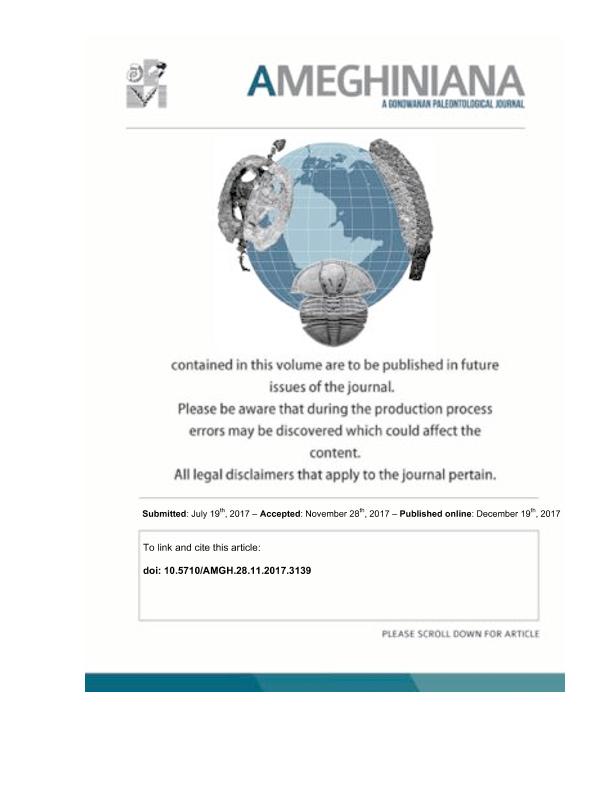Mostrar el registro sencillo del ítem
dc.contributor.author
Pisano, Maria Florencia

dc.contributor.author
Pommarés, Nicole Nadín

dc.contributor.author
Luengo, Mariel Samanta

dc.contributor.author
Fucks, Enrique Eduardo

dc.date.available
2018-08-29T18:17:15Z
dc.date.issued
2018-05
dc.identifier.citation
Pisano, Maria Florencia; Pommarés, Nicole Nadín; Luengo, Mariel Samanta; Fucks, Enrique Eduardo; Comparative Taphonomy of Mollusk Assemblages in Quaternary Freshwater Sequences from the Salado River Basin, Buenos Aires; Asociacion Paleontologica Argentina; Ameghiniana; 55; 2; 5-2018; 197-209
dc.identifier.issn
0002-7014
dc.identifier.uri
http://hdl.handle.net/11336/57549
dc.description.abstract
A partir del análisis de una serie de atributos tafonómicos sobre ejemplares de Heleobia parchappii provenientes de secuencias fluviales y paleolacustres holocenas acumuladas en la cuenca baja del río Salado, se ha realizado un estudio comparativo de la alteración superficial de sus conchas para evaluar si existen diferencias entre ambos ambientes. Los resultados principales permiten, a partir de un escalonamiento multidimensional no métrico (NMDS) y test de análisis de similaridad (ANOSIM) (R=0,31, p<0,01), reconocer y diferenciar estadísticamente los dos grupos de muestras, presentando aquellas recuperadas del ambiente paleolacustre características tafonómicas más similares entre sí, mientras las fluviales muestran mayor dispersión. El análisis de porcentaje de similaridad (SIMPER) permitió determinar que las variables descoloración y disolución fueron las más importantes para diferenciar ambos grupos, y los valores de los índices obtenidos (Grados Tafonómicos Totales) siempre fueron más altos en los ensambles paleolacustres evidenciando un deterioro mayor en ellos. Las diferencias encontradas en la preservación podrían explicarse por el tiempo de permanencia de los restos cerca de la interfaz agua-sedimento y las diferencias en la tasa de sedimentación en ambos ambientes. Estas diferencias estarían relacionadas con cambios en el régimen hidrológico (fluctuaciones en los niveles de agua superficial y subterránea) que, si bien afectan toda el área de estudio, son más intensos y frecuentes en las lagunas favoreciendo la descomposición de las conchillas acumuladas en este ambiente.
dc.description.abstract
From the analysis of the taphonomic attributes of the specimens of Heleobia parchappii found in fluvial and paleolacustrine sequences of the lower basin of the Salado River, the surface alteration of their shells was comparatively studied in order to assess the differences between both environments. The main results that were obtained by means of Non-Metric Multidimensional Scaling (NMDS) and analysis of similarity (ANOSIM) tests (R=0.31, p<0.01) enabled the recognition and statistical differentiation of both groups of samples. The taphonomic characteristics presented by those that were recovered from the paleolacustrine environment are more similar to each other, whereas those from the fluvial environment showed greater dispersion. Through the similarity percentage (SIMPER) analysis we could determine that the variables of discoloration and dissolution were the most important features to differentiate both groups, and that the values of the indexes (Total Taphonomic Grades) were always higher in the paleolacustrine assemblages, thus showing greater decay. The differences of preservation could be explained by the residence time of the remains near the water-sediment interface as well as by the differences in the sedimentation rate in both environments, which control the different exposure cycles of the shells. These differences would be related to changes in the hydrological regime (fluctuations in surface and groundwater levels) that, although affecting the entire study area, are more intense and frequent in shallow lakes, therefore favoring the decay of the shells accumulated in this environment.
dc.format
application/pdf
dc.language.iso
eng
dc.publisher
Asociacion Paleontologica Argentina

dc.rights
info:eu-repo/semantics/openAccess
dc.rights.uri
https://creativecommons.org/licenses/by-nc-sa/2.5/ar/
dc.subject
Alteration Of the External Surface
dc.subject
Climate Changes
dc.subject
Geomorphological Changes
dc.subject
Heleobia Parchappii
dc.subject.classification
Paleontología

dc.subject.classification
Ciencias de la Tierra y relacionadas con el Medio Ambiente

dc.subject.classification
CIENCIAS NATURALES Y EXACTAS

dc.title
Comparative Taphonomy of Mollusk Assemblages in Quaternary Freshwater Sequences from the Salado River Basin, Buenos Aires
dc.type
info:eu-repo/semantics/article
dc.type
info:ar-repo/semantics/artículo
dc.type
info:eu-repo/semantics/publishedVersion
dc.date.updated
2018-08-27T12:54:19Z
dc.identifier.eissn
1851-8044
dc.journal.volume
55
dc.journal.number
2
dc.journal.pagination
197-209
dc.journal.pais
Argentina

dc.journal.ciudad
Ciudad Autónoma de Buenos Aires
dc.description.fil
Fil: Pisano, Maria Florencia. Universidad Nacional de La Plata. Facultad de Ciencias Naturales y Museo. Cátedra de Geología del Cuaternario; Argentina. Consejo Nacional de Investigaciones Científicas y Técnicas; Argentina
dc.description.fil
Fil: Pommarés, Nicole Nadín. Universidad Nacional de La Plata. Facultad de Ciencias Naturales y Museo. Cátedra de Geología del Cuaternario; Argentina. Consejo Nacional de Investigaciones Científicas y Técnicas; Argentina
dc.description.fil
Fil: Luengo, Mariel Samanta. Universidad Nacional de La Plata. Facultad de Ciencias Naturales y Museo. Cátedra de Geología del Cuaternario; Argentina. Consejo Nacional de Investigaciones Científicas y Técnicas; Argentina
dc.description.fil
Fil: Fucks, Enrique Eduardo. Universidad Nacional de La Plata. Facultad de Ciencias Naturales y Museo. Cátedra de Geología del Cuaternario; Argentina
dc.journal.title
Ameghiniana

dc.relation.alternativeid
info:eu-repo/semantics/altIdentifier/doi/http://dx.doi.org/10.5710/AMGH.28.11.2017.3139
dc.relation.alternativeid
info:eu-repo/semantics/altIdentifier/url/http://www.bioone.org/doi/10.5710/AMGH.28.11.2017.3139
dc.relation.alternativeid
info:eu-repo/semantics/altIdentifier/url/http://www.ameghiniana.org.ar/index.php/ameghiniana/article/view/3139
Archivos asociados
